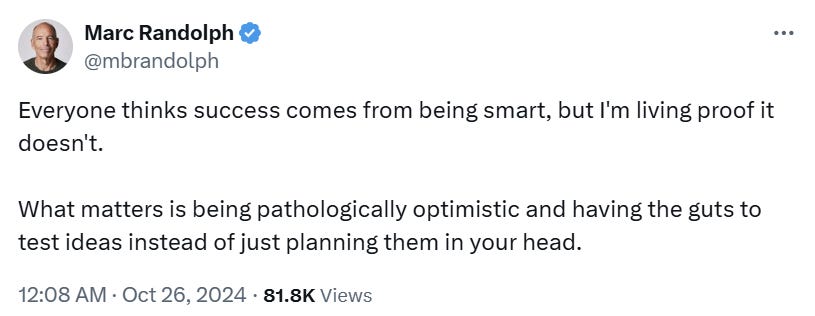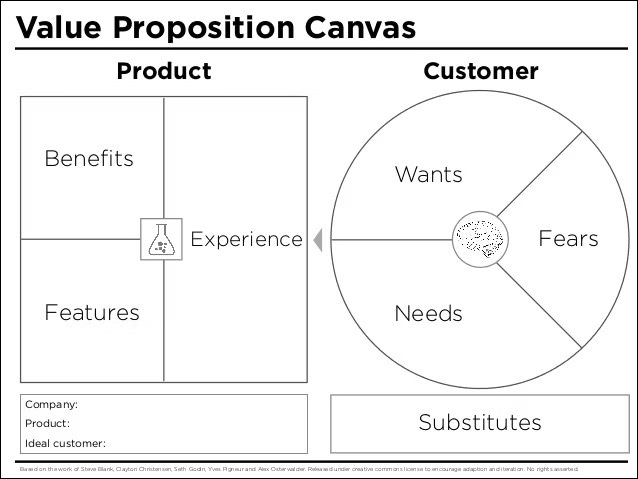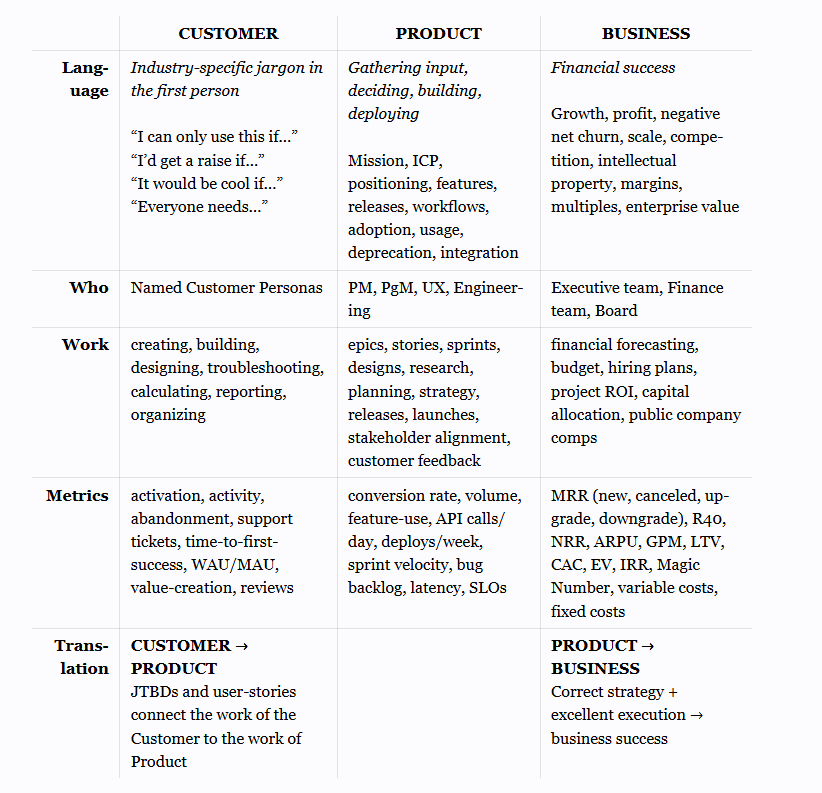How to Create A Value Proposition: A Four-Step Framework. | VC Jobs
The Market Size Mistake & Why Great Ideas Get Lost in Translation?
👋Hey Sahil here! Welcome to this bi-weekly venture curator newsletter. Each week, I tackle questions about building products, startups, growth, and venture capital! In today’s newsletter, we dive into -
Deep Dive: How to Create A Value Proposition: A Four-Step Framework.
Quick Dive:
Why Great Ideas Get Lost in Translation: Do You Know the Three Languages of Modern Business?
The Market Size Mistake - Tobi Lutke, the founder of Shopify
Major News: Neuralink competitor says its eye implant restored vision, Boeing is exploring sale of space business, General Catalyst Launches $8 Billion VC Fund & Ex-OpenAI researcher says company destroyed the internet.
Best Tweet Of This Week On Startups, VC & AI.
20+ VC Jobs & Internships: From Scout to Partner.
A MESSAGE FROM OUR PARTNER FINA MONEY
Flexible Finance Tools for Modern Money Management
Tired of juggling multiple finance tools?
Fina Money brings the flexibility you need with the simplicity you want.
All-in-one finance management that adapts to YOU
Create custom templates and formulas for personal & business tracking
Switch seamlessly between profiles for different financial goals
Track everything: from daily expenses to crypto investments
Powerful as a spreadsheet, simple as a document
Partnership With Us: Want to get your brand in front of 62,000+ founders, investors, executives, and startup operators? For details on our sponsorships, fill up this quick form or reply to this email as “Advertise” and we’ll get in touch.
VENTURE CURATORS’ FINDING
My favourite finds of the week.
Elizabeth (Partner at Hustle Fund) on How One Startup Turned Things Around After Running Out of Money. (Read)
Steve Jobs on how to perfect product design (Read)
Understanding how VCs think - The Math Behind Venture Capital. (Read)
a16z's Framework for Evaluating Startup User Growth Quality. (Read)
The YC approach on how to pitch your company. (Read)
Tactics to make an amazing product launch video (Read)
Why this AI startup raised money when they didn’t need to (Read)
6 things startup founders should avoid doing (Read)
More thoughts on why founder mode is so effective (Read)
Marc Andreessen's All-in-One Guide for Founders. (Read)
How Do VCs Decide to Take a First Meeting? - 12 Reasons. (Read)
AI is killing remote work - Sahil Lavingia (Read)
What KPIs should I track for SEO? - Cheatsheet (Read)
Paul Graham's Views on Competitor Analysis and a Framework for Performing It. (Read)
Circle’s Founder, Sid Yadav’s Views on Startup Valuation. (Read)
TODAY’S DEEP DIVE
How to Create A Value Proposition: A Four-Step Framework.
Your value proposition is at the heart of all your go-to-market activities in the startup stages of the business. If you get it right, and truly nail it, then it becomes this inspiring thing that will help you sell more, raise more, and clarify for everyone—including your people, what the urgent problem that you’re solving is.
The value proposition is what defines the business model of your company, and explains how it will generate revenue and profit. It explains who your customers will be and why they will use your product.
Investors won’t look twice at a company that hasn’t nailed the value proposition. After all, if you don’t know what is going to make your startup unstoppable, why should they back it?
So, if you want your startup to get off the ground and fly, you’re going to want to put some effort into the value proposition right at the start.
It’s hard - coming up with a value proposition when you haven’t yet got the market-ready product is hard. Don’t let this get you down. Get the pot of coffee ready, put whatever tunes on that get you in the mood to concentrate, and settle in for a session.
While crafting a value proposition demands careful thought, the approach is surprisingly simple. A concise four-step method provides all you need to complete a value proposition canvas. This process will guide you to distil your insights into a single, powerful sentence that captures your offering's unique worth.
The value proposition canvas tool looks like this:
What this tool does is help you to focus. You want to focus your strategy on that magic fit between what you’re going to be making and why people will buy it. You break those two things down and there’s only a couple of elements to each. And that’s why it’s so important that you address all of them—all six of them above—within your value proposition.
Think of it like a paint-by-numbers game. The picture isn’t finished until every bit of the canvas is fully painted.
The next question you’re going to have is how you go about getting the paint onto the canvas. Here’s a simple approach:
1) Start with the problem..
Why are you creating this product? What's the purpose of your startup? It's all about tackling a pressing issue that people - your future customers - are facing. Take Airbnb, for example. They saw a problem: expensive hotel rooms and a lack of unique, local accommodation options for travellers. That was their starting point.
Why go through this step? Because too many startup entrepreneurs lead with “our product does…”—and that’s not the right approach.
Assume that people don’t want more products. We’re all already spending too much on too many products as it is. Assume that people want to be able to solve problems, and are willing to spend money to achieve that solution. That’s the point of step one. It gets you thinking in the right direction.
2) Ask yourself what is the risk associated with the problem
Ask yourself: "What happens if someone doesn't fix this issue?" This is crucial because while you've identified a pressing problem, you need to understand its real impact.
Some problems have bigger consequences than others. For instance, think about a company like Dropbox. They tackled the problem of file sharing and storage. Without a solution like theirs, people risked losing important files, struggled to collaborate on projects, and wasted time trying to share large files.
This step is key because it gets to the heart of your value proposition. If you can get a potential customer to realize, "We're wasting hours every week on file management, and it's costing us money," and then show them your solution, you've got their attention.
It's about making the pain point clear. When people see the real cost or risk of not solving the problem, they're more likely to see the value in your solution. This approach helps you connect with your customers on a deeper level, showing that you truly understand their challenges.
3) Now it's time to look at your product through the lens of problem-solving.
Start by listing your product's features and benefits, but don't stop there. The key is to connect these to the problems you've identified in steps one and two.
Remember, your potential customers or investors aren't going to be excited by a dry list of features. They'll love those once they're using your product, but to grab their attention initially, you need to show how these features solve their problems.
Let's take Slack as an example. They could list features like channels, direct messaging, and file sharing. But what's more important is how these features solve communication problems in the workplace. How do they reduce the time wasted on endless email chains? How do they improve team collaboration?
Ask yourself: How completely does your product address the problem? The more thoroughly you solve the issue, the more interested people will be. If Slack can show that its platform practically eliminates the need for internal emails and dramatically improves team productivity, that's a powerful proposition.
This step is about making the connection clear between your product's capabilities and the customer's needs. It's not just about what your product does, but how it makes their problems disappear. That's what will catch their attention.
4) Finally, prove it
This will be something you add to your value proposition later, once you’ve got customers, but proof that the solution works and delivers what you’re promising will be critical as you start to scale the business. Customer case studies that hone in on the problem and solution can help to explain in real terms the benefits of giving you their business.
So, make sure that some of your first customers become case studies that highlight what you’ve done for them. Future customers will expect to see this.
Once you’ve completed these steps, you’ll then be able to “paint” in the value proposition canvas. From there, the last task is to take that information and summarize it in no more than two sentences that can be recited in 30 seconds.
Some great examples of value propositions
Slack: "Make work life simpler, more pleasant and more productive."
Slack took the messy world of work communication and made it fun and efficient. They saw the problem of fragmented conversations across different apps and solved it by creating a single, user-friendly platform. It's like a social media experience but for work.
Grammarly: "Great writing, simplified"
Grammarly nailed it with this straightforward promise. Instead of getting technical about AI and spell-checking, they focused on the result: better writing. It's a simple, powerful message that resonates with their target audience.
Uber: "The smartest way to get around"
While Uber is not a startup anymore, Uber's early value proposition is worth noting. They identified the hassles of traditional taxis - unpredictable waiting times, payment issues, navigation problems - and offered a smart, tech-driven solution. Their message implies convenience and efficiency, addressing the core problems of urban transportation.
Remember -
The value proposition is not about selling your business. It’s about selling what the business will do for the customer. This customer-centric statement proves that you’ve identified a problem in people’s lives and their jobs and that you’ve got a solution for it.
VENTURE CURATOR HUB
Access Curated Resources, Support Our Newsletter
Early Stage Startup Financial Model Template For Fundraising (Access Here)
2700+ US Angel Investors & VC Firms Contact Database (Email + LinkedIn Link) (Access Here)
400+ French Angel Investors & Venture Capital Firms Contact Database (Email + LinkedIn Link) (Access Here)
1000+ Euro Tech Angel Investors & VC Firms Database (Access Here)
350+ Indian Angel Investors & Venture Capital Firms Contact Database (Email + LinkedIn Link) (Access Here)
QUICK DIVES
1. Why Great Ideas Get Lost in Translation: Do You Know the Three Languages of Modern Business?
In boardrooms and Slack channels across the globe, a fascinating phenomenon plays out daily: Teams who share the same goals often struggle to truly understand each other. It's not because of a lack of effort or intelligence – it's because they're unknowingly speaking three distinct languages: customers express their daily challenges and dreams, product teams communicate in features and sprints, and business leaders think in growth metrics and market dynamics.
When these languages collide without translation, great ideas can get lost in the shuffle. Let's break down these languages and learn how to translate between them.
The Three Languages at a Glance
Why We Need Translation
Picture this: A CEO asks her product team, "Why isn't growing revenue your top priority this quarter?" Meanwhile, the product manager responds, "We're focused on delivering customer value as quickly as possible." They're both right, but they're speaking different languages.
Or consider when a customer says, "Everyone obviously needs this feature!" while the product team is trying to understand the deeper problem they're trying to solve. Six months later, when that specific feature isn't built, the customer feels ignored – even though the product team may have solved their problem in a different, more scalable way.
The Three Languages in Detail
Customer Language
Customers speak in terms of:
Their immediate needs and frustrations
What would make them look good to their boss
How they could make more money or save time
What would make their job easier
Real-world problems they face daily
Product Language
Product teams speak in terms of:
Sprint planning and release cycles
User stories and feature requirements
Technical constraints and possibilities
Usage metrics and adoption rates
Product strategy and roadmaps
Business Language
Business leaders speak in terms of:
Monthly recurring revenue (MRR)
Customer acquisition costs
Growth metrics and projections
Market competition
Investment returns
Building Bridges: How to Translate
Customer → Product Translation
The key here is Jobs To Be Done (JTBD) and user stories. Instead of just hearing "I need feature X," product teams need to understand:
What is the customer trying to accomplish?
What's blocking them today?
What would success look like?
For example, when a customer says "I need better security," they might mean:
"I'm worried about getting hacked"
"I need to prove to my boss we're protected"
"I can't afford a security breach"
Product → Business Translation
Product teams need to show how their work connects to business goals:
How features drive revenue growth
Why certain investments matter long-term
How product improvements reduce churn
What metrics show success
Making It Work
The secret to success isn't just understanding these different languages – it's actively working to translate between them. When teams make this effort:
Customers feel heard and valued
Product teams build the right things
Business leaders can see clear progress
Everyone moves in the same direction
Remember: No one is wrong in their perspective. They're just speaking their own language. Our job is to help everyone understand each other and work together toward shared success.
For more details, I highly recommend reading this great article by Jason Cohen. Worth a read!
2. The Market Size Mistake - Tobi Lutke, the founder of Shopify
One of the most common reasons founders face rejection from investors is due to a small market size. Even Tobi Lutke, the founder of Shopify, has explained this. In the early days, many investors passed on Shopify because they believed the addressable market was too limited.
Lutke clarifies, "At the time, there were only about 40,000-50,000 online stores. Even if Shopify captured 50% of that market, it still wouldn’t be considered a venture-scale business."
When Tobi ran into the VC partner a few years ago, the partner asked Tobi what he missed (Shopify is valued at almost $100 billion today).
Tobi explained:
“You were correct, but what you didn’t realize was that Shopify was the solution to the very problem you identified. The reason there were only 40,000 online stores was because it was hard, expensive, and everyone who tried ran into all these brick walls of complexity, which Shopify, one after another, smoothed over and made simple to do.”
Tobi believes this is a common mistake:
“What a lot of free-market thinkers don’t understand is that between the demand and eventual supply lies friction. And I think that friction is probably the most potent force for shaping the planet that people just generally do not acknowledge… That was my theory when I turned my snowboard store into Shopify: there were a lot more people like me except there was too much friction which we needed to solve.
And Shopify has proven that every time we make the process simpler, there’s more consumption. At this point, we have a million merchants on Shopify, which is a mind-blowing number. So friction is a major component, and it’s something that software is uniquely good at reducing.”
You can watch the full video here Tobi Lütke The Creator of Shopify
Join 36000+ Founders, Investors and Startup Enthusiasts Getting Tactics To Build, Learn and Implement About Startups and Venture Capital.
THIS WEEK’S NEWS RECAP
Major News In VC, Startup Funding & Tech
25% of Google's new code is AI-generated. (Read Here)
MrBeast Being Investigated Over $23 Million Crypto Insider Trading. (Read Here)
Russia fines Google $20.5 decillion for blocking YouTube channels. (Read Here)
Musk’s xAI will raise billions at a $40 billion valuation. (Read Here)
OpenAI planning to build its first AI chip in 2026. (Read Here)
→ Get the most important startup funding, venture capital & tech news. Join 26,000+ early adopters staying ahead of the curve, for free. Subscribed to Venture Daily Digest Newsletter.
TWEET OF THIS WEEK
Best Tweet I Saw This Week

TODAY’S JOB OPPORTUNITIES
Venture Capital Jobs & Internships
Get access to our all-in-one VC interview preparation guide—check it out here. For a limited time, we are offering a 30% discount. Don’t miss this.
Senior Director of Marketing and Communications - Aegis Venture | USA - Apply Here
Visiting Analyst Climate Tech - Speedinvest | UK - Apply Here
Visiting Analyst Climate Tech - SpeedInvest | France - Apply Here
Analyst - SE Ventue | USA - Apply Here
DeepTech & HealthTech Investment Analyst - Blume venture | India - Apply Here
Strategic Investment Associate- Venture Capital - Wells Fargo | USA - Apply Here
Biotech Network Partner - 2048 Ventrue | UK - Apply Here
Associate, Cyber - Flagship - Energy impact partner | USA - Apply Here
Senior Associate - Ardent Venture Partner | USA - Apply Here
Associate -McKesson Venture | USA - Apply Here
Investor Relations Associate - Forum Venture | USA - Apply Here
Portfolio Manager - Antler | India - Apply Here
Senior Director - Illinois Ventures | USA - Apply Here
Portfolio Development Manager - Insurtech - Munich Re Venture | USA - Apply Here
Venture Capital Managing Director/Director - Connecticut Innovation | USA - Apply Here
Investment Director - Enbw venture | Germany - Apply Here
That’s It For Today! Happy Friday. Will meet You Next Friday!
✍️Written By Sahil R | Venture Crew Team







